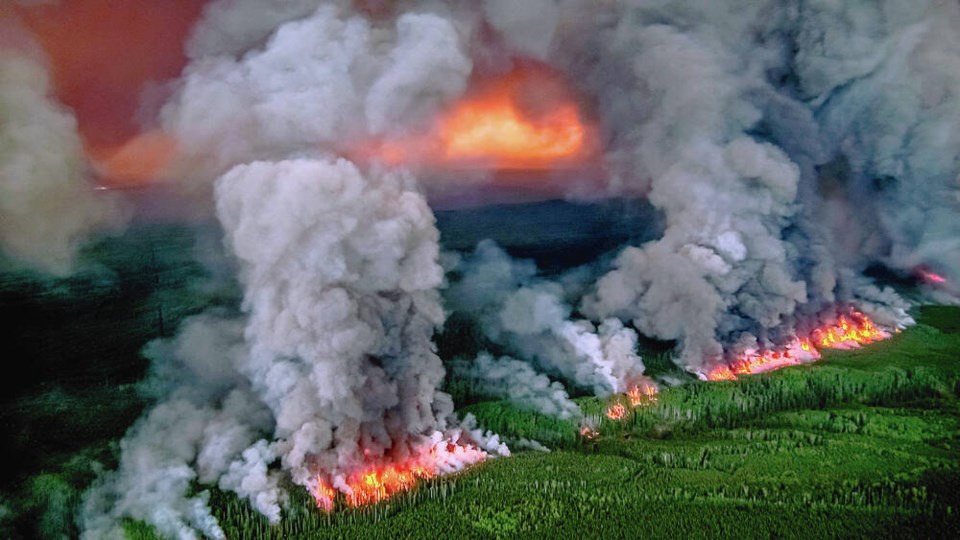A drought that has lingered across much of B.C. since the fall of 2022 could be a harbinger of a “grim” wildfire season, forecasters are warning.
Victoria-based Environment Canada meteorologist Armel Castellan said there is no indication that spring weather will be wet enough to temper what he describes as “unbelievably low levels” of precipitation and snowpack over the past 18 months in most areas of B.C.
“We’re still not catching up for the lack [of precipitation] that we’ve had so consistently since August of 2022.”
The dry conditions are particularly bad in the Prince George Fire Centre in B.C.’s northeast corner, where two new fires have ignited in the past month.
There are still 93 listed fires from last season across the province, the vast majority of which are in the Prince George region and have been burning or smouldering since the summer.
However, other fires ignited as recently as late October in the Cariboo Fire Centre, and two in the Prince George area sparked as recently as the end of January and this past Friday.
While none is listed as a wildfire of note — which indicates a fire that is significant in scale or threatens people and property — it’s a worrying predictor of what might be ahead leading into summer.
Castellan said a rainy stretch from November to January has “somewhat replenished” water supplies in several regions, including the B.C. coast, but “every [weather] station we monitor is at a deficit.”
He noted that drought is not just about how much precipitation falls. Seasonal temperatures also play a key role.
For instance, Castellan said December 2023 was the warmest on record in many parts of B.C., including 91‘≠¥¥, Abbotsford and Comox. That means more evaporation of what rain does fall and less snow at higher elevations.
A generally warming climate thus prolongs and intensifies drought. “It’s a massive piece if temperatures are warming,” he said.
Analysis of the snowpack shows the lowest depths since data has been collected, at least from the 1980s to the present. “In the last 40 or 50 years, this is as bad as it’s ever gotten from a snow perspective.”
While snowfall is in the forecast this week, it isn’t likely to do much to change the reality that the snowpack is at 60 per cent of normal levels in B.C.’s mountains heading into spring.
The Ministry of Forests said the B.C. Wildfire Service and its partners have pivoted to a year-round rather than seasonal model and are pouring money from the 2024 B.C. budget into fire prevention and management.
The provincial budget calls for $154 million more operating cash and $21 million in capital over the next three years for added wildfire response, recovery and infrastructure resources, the ministry said in a statement.
Premier David Eby said last week he is “profoundly worried” about what lies ahead, noting the severe drought and the billion-dollar battle last summer — B.C.’s most destructive wildfire season on record.
The 2024 budget includes $38 million more to hire wildfire service crew leaders and front-line staff who will work to protect structures, prevent and reduce the risk of fires, and help with recovery of ecosystems and repair infrastructure affected by wildfires.
While Alberta has declared an early start to wildfire season, B.C. is now on watch for fires year-round, largely due to the effects of a warming climate and increasingly extreme weather events, said Castellan.
For example, Castellan said B.C.’s northeast plunged to lows in the minus-40s Celsius in January before a sudden swing into the positive teens.
The unsettled weather in the area even led to a pulse of lightning that, while it didn’t spark a wildfire, suggests the wildfire service needs to be on alert for the potential of lightning-caused blazes even now.
Castellan said the national weather agency crunched the numbers on what to expect this spring in mid-February, and models show temperatures are likely to be above seasonal from March through May virtually across Canada, save for some parts of the far north.
Forecasting spring precipitation is trickier, said Castellan, although it is clear that the El Niño pattern that has prevailed for the past few years has been fading since about December. That usually leads to drier and cooler conditions, but the transition to La Niña might not have a big effect on B.C. weather patterns until perhaps next winter, he said.
“Everything is still on the table [forecast-wise], but it’s weighted to grim at this point,” he said. “We have all the indications that this spring and summer are heavily weighted toward a higher wildfire risk.”
That likely means more smoke and heat across much of the province this spring and summer. And it’s a worry that should be on everyone’s mind, not just firefighters and emergency managers, he said.
“Anybody who has a set of lungs will remember how traumatizing it is from a health point of view having wildfires in the neighbourhood from May until mid-winter.”



